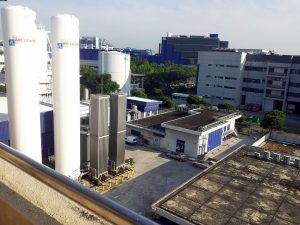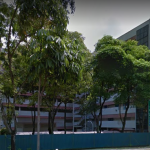Overall rents across Singapore’s industrial sector remained unchanged quarter-on-quarter (QOQ) in Q4 2019, the second straight quarter of no-change. For the full year 2019, industrial sector rents were up 0.1% year-on-year (YOY), mainly due to the improvement in business parks.
 In Q4 2019, the occupancy rate slipped by 0.1 percentage point (ppt) QOQ and YOY. Meanwhile, prices of industrial sector properties saw decreases of 0.2% QOQ and 0.3% YOY as the overall land lease tenures continue to decay.
In Q4 2019, the occupancy rate slipped by 0.1 percentage point (ppt) QOQ and YOY. Meanwhile, prices of industrial sector properties saw decreases of 0.2% QOQ and 0.3% YOY as the overall land lease tenures continue to decay.
Commenting on the performance of the industrial sector in Q4 2019, Ms Tricia Song, Head of Research for Singapore at Colliers International, said:
“Rents and occupancy rate in Industrial Sector
The All-Industrial rental index continued the stabilisation trend – which started from Q4 2018 – and remained unchanged QOQ in Q4 2019. This marked the ninth consecutive quarter where rents remained rangebound, wavering between -0.1% and +0.1%. The latest numbers put the All-Industrial rental index at 13.6% below the peak in Q2 2014.
Overall occupancy rate, however, declined marginally by 0.1 ppt QOQ to 89.2% after holding at 89.3% for four straight quarters, mainly dragged by the single-user factory segment which saw the occupancy rate dropped by 0.3 ppt QOQ during Q4 2019. On a yearly basis, the occupancy level dropped by 0.1 ppt in 2019, compared to 2018 as full-year 2019 net new supply (at 9.3 million sq ft) outstripped net new demand (at 7.8 million sq ft).
Factory
Rents for multiple-user factory dropped by 0.1% both QOQ and YOY in Q4, due to the rental decline of 0.5% QOQ in the West Region – the only region where rents fell in the quarter. In contrast, the North Region saw a rental uptick of 0.2% QOQ, possibly due to stronger demand for multiple-user factory space amid limited supply in this planning region. The islandwide occupancy rate for multiple-user factory improved by 0.4 ppt QOQ to 87.5%.
The single-user factory segment continued to see rental increment for the third consecutive quarter, rising by 0.1% QOQ and 0.5% YOY. The occupancy level, however, dropped by 0.3 ppt QOQ to 90.8% in Q4.
Business Park
Business park rents remained firm on healthy leasing demand, rising for the fourth consecutive quarter by 0.1% QOQ, the same pace of growth as Q3. Overall occupancy in business park space was unchanged QOQ at 86.2%, with improvements noted in Viva Business Park, International Business Park, and CleanTech Park, which saw occupancy level increased by 3.1 ppt, 0.1 ppt, and 1.3 pp, respectively.
On a yearly basis, the business park segment ended 2019 on a high note, with overall rent rising by 1.3% YOY and occupancies rising by 1.3 ppt YOY on the back of strong leasing demand from the technology, media and e-commerce sectors. We note that these companies have continuously gravitated towards newer business park spaces for better accessibility, good amenities and greater cost savings.
Warehouse
Rents for warehouse space turned around after two consecutive quarters of decline, posting a minor uptick of 0.1% QOQ in Q4, as global trade outlook improved towards the end of 2019. For full-year 2019, warehouse rents declined by 0.2%, the sixth straight year of decline, albeit the slowest rate of decline in six years.
However, warehouse occupancy declined marginally by 0.1 ppt QOQ to 88.0% as supply more than quadrupled demand to 194,000 sq ft (net). For the full-year 2019, warehouse occupancy deteriorated by 1.5 ppt.
Prices
The All-Industrial price index dropped by 0.2% QOQ in Q4 2019, with declines in both single-user factory and multiple-user factory segments. On a yearly basis, the All-Industrial price index slipped by 0.3% YOY in 2019, led by multiple-user factory which declined by 0.6% YOY, while single-user factory was up by 0.3% YOY.
We note that multiple-user factories with long land tenures of above 60 years continued to see uptick in prices, at 0.1% QOQ in Q4 2019, reflecting resilient demand from investors for industrial properties with longer remaining leases. Also, based on JTC record, the total number of caveats lodged for industrial properties across all segments in 2019 increased by 7% YOY, representing healthy investment demand for industrial assets during the year.
Future Supply
The industrial stock completed in the last quarter of 2019 was minimal at 27,000 sq ft (net). This brought total new supply in full-year 2019 to 9.3 million sq ft (net), of which more than 65% are single-user factory and the rest mainly warehouse spaces. In 2019, total new supply (net) across all industrial types was a robust 60% increase from 2018, but still 55% behind the record level of 20.9 million sq ft (net) witnessed in 2017.
Going forward, JTC forecasts new supply in 2020 to increase significantly to 23.7 million sq ft (gross), with 39% in single-user factory, 39% in multiple-user factory, 15% in warehouse space and 7% in business park. Assuming an 80-90% building efficiency for the future upcoming supply, we expect the total industrial space completed in 2020 to more than double YOY to around 20 million sq ft (net).
New supply across all industrial types is set to come off in 2021 to around 8.1 million sq ft (gross) before picking up again in 2022 at 16.1 million sq ft (gross), led by factory spaces which account for 83% of total supply. We note that business park supply is set to intensify from 2023 onwards, starting with 2.4 million sq ft (gross) of new supply in 2023 from the completion of the first buildings in Punggol Digital District.
Macro environment
Based on advance estimates from the Ministry of Trade and Industry (MTI), Singapore’s GDP grew by 0.8% year-on-year (YOY) in Q4 2019, slightly higher than the 0.7% in Q3, dragged by the continuous decline in the manufacturing sector which contracted by 2.1% YOY.
For full-year 2019, Singapore economy grew by only 0.7%, the weakest growth in a decade since the 0.1% expansion during the global financial crisis in 2009. Nevertheless, 2020 is set to improve slightly, supported by a few positives for Singapore’s external outlook such as a clearer picture of Brexit status and the US-China “Phase 1” trade deal. MTI forecasts 2020 GDP growth to be in the range of 0.5-2.5% while Oxford Economics, as of 9 January 2020, has put Singapore’s 2020 GDP growth at a modest 1.4% on sluggish export outlook and soft domestic demand.”







